#birkbeck road
Text
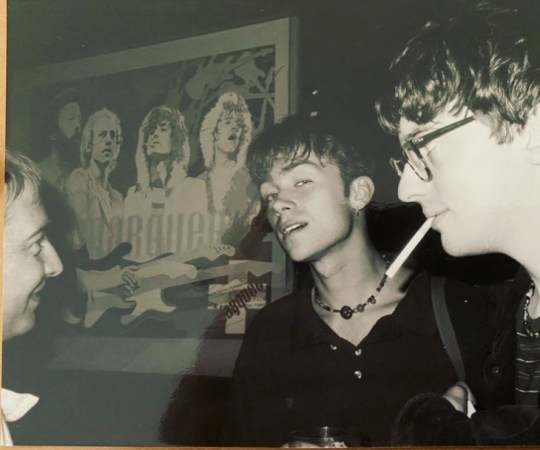
Damon & Graham at the Marquee (in Charing Cross Road) chatting to Stuart Maconie 1991
photo by Polly Birkbeck [X]
153 notes
·
View notes
Text
Court Circular | 13th December 2023
St James’s Palace
The Princess Royal, Patron, Catch22, this morning visited Include London at 191 Freston Road, London W10, and was received by the Earl Cadogan (Deputy Lieutenant of Greater London).
Her Royal Highness, President, Racing Welfare, today attended a Beneficiaries’ Christmas Luncheon at Epsom Racecourse and was received by Mr Peter Lee (Deputy Lieutenant of Surrey).
The Princess Royal this afternoon received Captain Marcus Hember RN upon relinquishing his appointment as Commanding Officer, HMS ALBION.
Her Royal Highness, Chancellor, University of London, this evening attended a Dinner at Mansion House, London EC4, to mark the Two Hundredth Anniversary of Birkbeck.
15 notes
·
View notes
Text
Netflix true crime
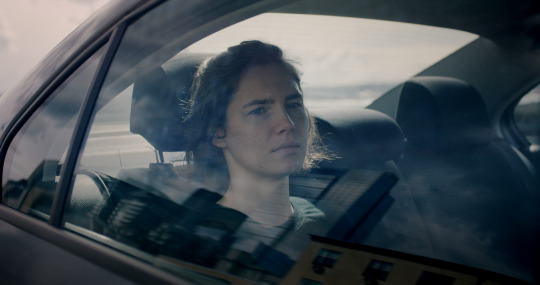
Amanda Knox
While on a foreign exchange trip in Perugia, Italy, Amanda Knox, an American college student, was accused of brutally murdering her roommate, Meredith Kercher. Knox became a media sensation and served almost four years in an Italian prison before Italy’s highest court exonerated her in 2015. This illuminating documentary finally gives Knox a chance to speak on her own terms

American Nightmare
Dubbed the “real-life Gone Girl,” the three-part series from The Tinder Swindler filmmakers Felicity Morris and Bernadette Higgins takes viewers on a journey through one couple’s harrowing experience with a home invader. On March 23, 2015, Denise Huskins and her boyfriend, Aaron Quinn, were awakened in the middle of the night by a stranger. Quinn called the police and explained what happened, saying the intruder had tied them up, drugged them, and taken Huskins for ransom. But no one — not even investigators and police — believed them.

Athlete A
This 2020 documentary follows the survivors of USA Gymnastics (USAG) doctor Larry Nassar’s abuse, as well as the team of investigative journalists from The Indianapolis Star who initially broke the story. Many gymnasts in the USAG were experiencing horrific acts behind closed doors. Through interviews with survivors and the journalists who brought the story to the world’s stage, Athlete A details how the USAG covered up Nassar’s abuse for years
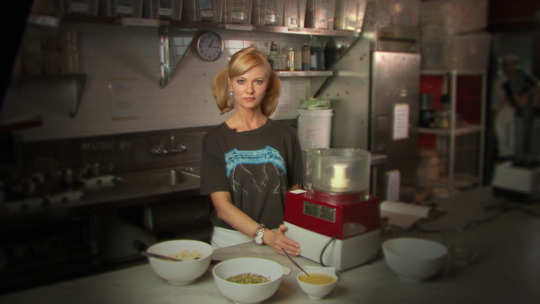
Bad Vegan: Fame. Fraud. Fugitives.
Sarma Melngailis was once regarded as the vegan queen of NYC. As the restaurateur behind Manhattan’s Pure Food and Wine, Melngailis’ restaurant served as a hot spot for vegans and celebrities alike. After meeting a mysterious man on the internet who promises to help grow her empire, Melngailis finds her life — and restaurant — veering off the rails

Casting JonBenet
In 1996, 6-year-old JonBenet Ramsey was killed in a bizarre and widely covered case that spawned hundreds of conspiracy theories, thousands of tabloid covers, and no real answers. Casting JonBenet uses a mix of documentary and dramatic reenactments to not only retell the crime but also describe its impact on our collective psyche. In this real-life casting call, actors audition for the roles of the crime’s key players, while also sharing their own theories of what happened to the young pageant star.
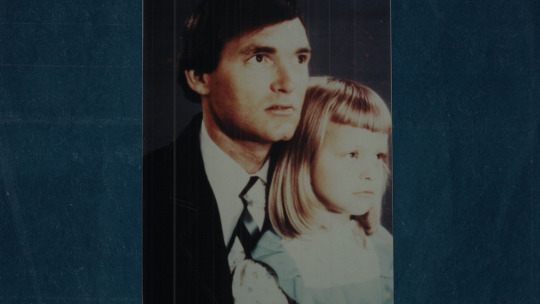
Girl in the Picture
A young woman is found dying on the side of a road from a hit-and-run, but investigators soon learn that it wasn’t a simple accident. After her death, she left behind an infant son and a much older husband — who mysteriously appeared in a photo with the victim as a child that, years later, was passed along to investigative journalist Matt Birkbeck. As he dug in, it became clear that the woman wasn’t who she said she was — and neither was her “husband.” It took more than 20 years to disentangle the web of lies to reveal the true, grim story of her real identity.
Credit:
7 notes
·
View notes
Text
Caravaggio's Rome is My Rome the book I've been writing for the past 20 years
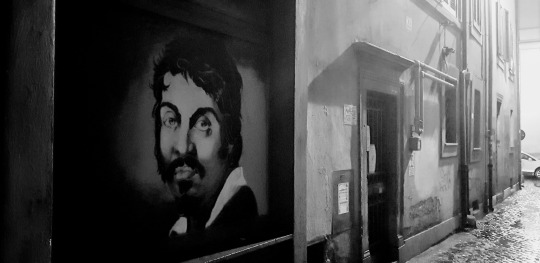
When I first moved to Italy in 2003 I began researching, writing, taking photographs, collecting recipes, stories, experiences; I began gathering together the material that would become The Book, My Book
The book, my book began its life as "Under a Fig Tree in Rome", my love letter to the five years I lived on the streets, named after my first home, a fig tree on the Tiber Island.

In first-person narrative I told the tales that weaved together those five years. A way of apologising, forgiving, celebrating, remembering those faces & places. An exorcism of ghosts of sorts as most of the characters i wrote about are dead now. My book is a memorial. A glorification of the inglorious. But it was no Kerouac. I printed and bound "Fig Tree" and placed it in my bookcase.

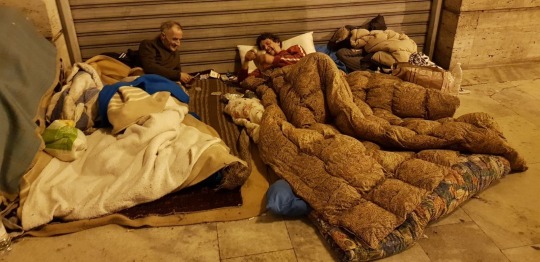
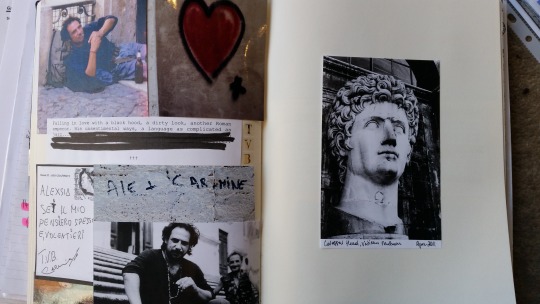


My obsession with Rome remained a roaring fire in my heart after i left the city in the summer of 2007. By 2009 I enrolled in the history of art program at Birkbeck, University of London, graduating with a Masters degree in 2017, the majority of my credits being Roman/ Renaissance modules. I had learnt a great deal which made me aware that I knew absolutely nothing.


In 2016 I began writing about Rome again, but from a different angle. My boyfriend had a rickshaw which he used to transport tourists around the city. I realised the rione of Rome I had lived in & written about in The Book, My Book was also the backdrop of Michael Merisi da Caravaggio's twelve years in Rome at the turn of the seventeenth century.
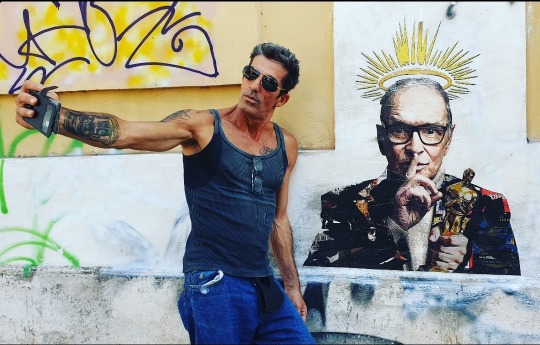
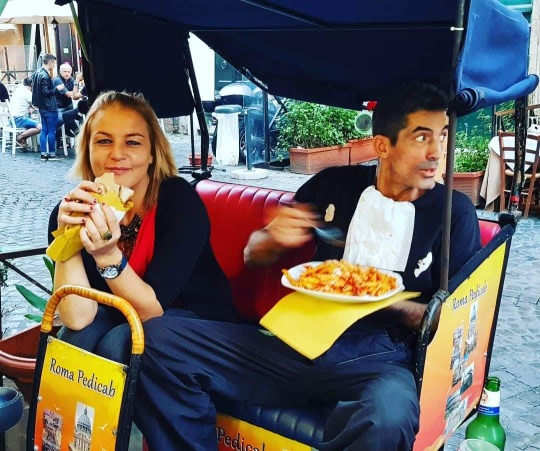



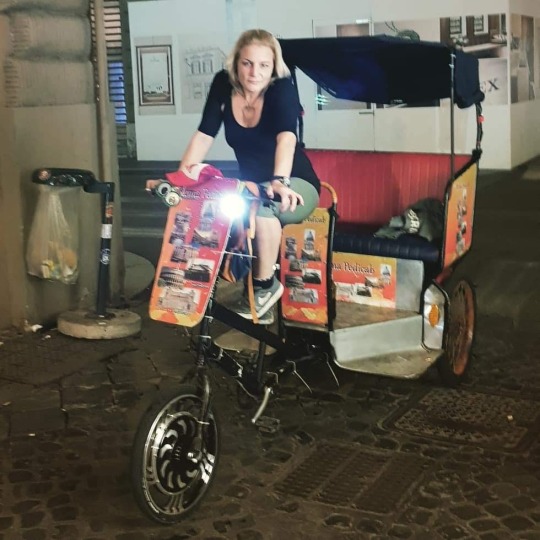

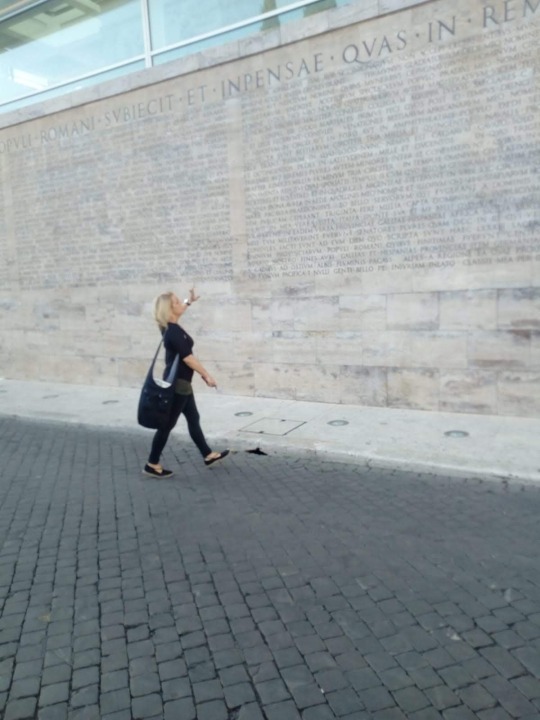


I began to draw different lines on the same map, joining dots, making connections. I wrote another book, based on a series of walks in which you saw the paintings of Caravaggio as well as where he lived, where he drank, where he worked overlayed with where I lived, where I drank, where (and what) I wrote. Caravaggio's Rome is My Rome.
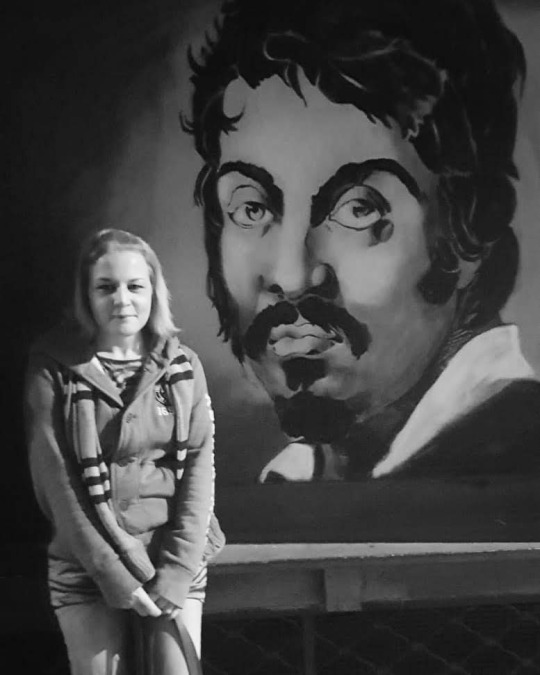

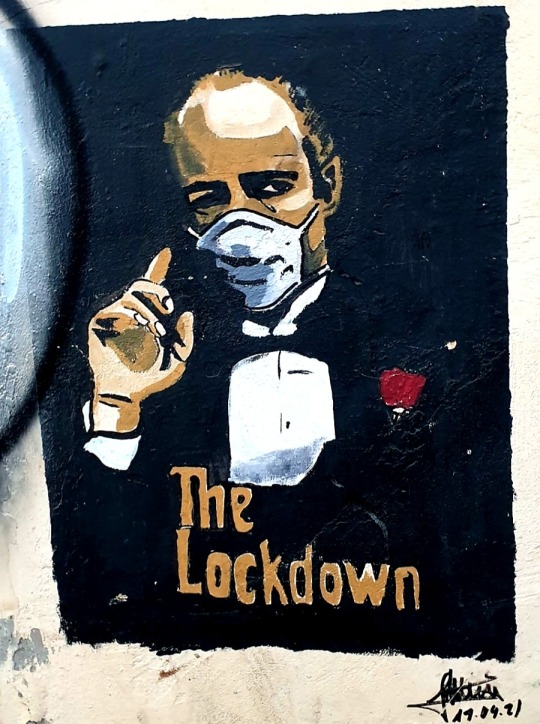
The lockdowns of 2020-21 changed everything for Francesco & I. No tourists, no work. Required by law to stay at home, 25 km east of Piazza Navona, I began to explore my patch the city, Giardinetti, just off exit 18 of the Grande Raccordo Anullare, the ring road around Rome. My geography had changed. & then our circumstances changed too.
In December 2022 Francesco had a car accident that left him semi-paralysed. From the moment he was discharged from hospital in February of this year I became a cook, cleaner & carer. My Rome work became a Mrs Beaton-like grimoire of recipes, household management tips, hedgewitchery and notes on a nightmare commute - with a wheelchair - across the city relying on (extremely unreliable) public transport.

My role changed, so my Rome changed and the book, my book gets re-written, again. More like a Cy Twombley painting than ever - scribble, scribble, scribble, WORD IN CAPITAL LETTERS, whitened, sanded back, text comes through the titanium white.

#caravaggios Rome is my Rome#writing#under a fig tree in Rome#rome#bachelor of arts#master of arts#birkbeck#University of London#cy twombly#Mrs Beetons Book of Household Management#grimoire#creative process
2 notes
·
View notes
Text
Federal government plans to integrate local defense forces into the police and national army has led to days of violent protests across Ethiopia's northern Amhara region. There were reports of several people being shot at during protests held on Tuesday, which marked the sixth consecutive day of rallies against the government plans.
A resident of Dessie town, one of the areas that witnessed some of the most violent clashes, told DW that Tuesday's unrest had largely receded.
"There was occasional shooting in the morning but I think it was to disperse them [the protesters]. Now the shooting has stopped but roads are still closed," the resident said.
Meanwhile, similar developments were observed in Bahir Dar, the capital city of the Amhara region. Independent Ethiopian analyst Alemnew Mekonnen told DW that the anger observed on Tuesday had subsided, while some major roads remained blocked.
"Now things are calming down. Yesterday, there was a big demonstration in different areas. There was a mess yesterday but now, from all sides, things are calming down," Mekonnen said.
Stability after days of chaos
Mekonnen said that life is gradually returning to normal for residents after a week of instability. "Some workers are back in their offices. Transport services have been started. Things now are in a normal track," he said.
Curfews had been imposed on three major cities of Gondar,Dessie and Debre Birhan to prevent the protests from spiraling out of control. This was reportedly accompanied by an internet blackout, a tactic previously used by the Ethiopian government to quell dissent.
Eshetu Getnet, an eyewitness to the days of violence between Amhara and Oromo militants in the neighboring areas of Ataye and Jile, told DW that the federal defense forces were instrumental in stabilizing the situation.
"It is commendable that the defense is now working fairly," Getnet said.
Amhara left in a vulnerable position?
Ethiopian federal authorities have said that dissolving the Amhara Special Forces (ASF) and other militia groups in Ethiopia's 11 regions and integrating them into the federal army or police will create a strong and unified force in a country, where divisions have resulted in hundreds of thousands of deaths over the past 50 years.
But the protesters in Amhara believe the government's plans would leave their state vulnerable to attack from other regions. This comes after the ASF also played a crucial role in the government's war against Tigrayan rebels — a conflict that killed thousands and displaced many more.
The dismantling and integration into the national army of the ASF is part of the peace deal with Tigray, the stipulations of which are currently being implemented by the federal government.
Mekonnen told DW that the violent protests of recent days were largely triggered by a lack of engagement with the regional forces and militia on the government's part, as the details of the peace plan were being hashed out. "As far as I know, there was no discussion between the people and the special forces," he said.
Blen Mamo Diriba, an Ethiopian researcher at the Birkbeck College at the University of London, said that despite this, the recent escalation of tensions was "unnecessary."
"Caution is of high demand to prevent another bloody civil war," she cautioned on Twitter, underscoring the fragility of peace in the region.
Other analysts like Mekonnen have also called for more engagement between the federal government and regional leaders to resolve the situation in Amhara.
"The authorities should discuss with the people, with the special forces, with other stakeholders, so there can be some understanding," Mekonnen told DW.
Opting for mediation
One of the leaders of the Fano militia which fought alongside the federal forces against Tigrayan fighters in the recent war said that the way forward was through mediation.
"We have a cease-fire. It is settled. We will negotiate," the militia leader, who wanted to remain anonymous, told DW.
"Elders and church fathers are also engaged [in resolving the crisis]," he added, highlighting the importance of including local religious leaders in these talks.
Researcher Diriba, however, said that community leaders from the region should primarily focus on convincing the public to refrain from impulsive and violent acts, stressing that resolving the current crisis in Amhara was key to ending the precarious overall security situation in the country.
"Ethiopia must break this vicious cycle of violence. And the government ought to deliver on its duty in a legitimate manner without initiating hostile encounters with notable consequences on the nation's political stability and national security."
2 notes
·
View notes
Text
Amy Patel Meets Graham Folger During Criminology Course at Birkbeck University (MAG – 003 – Across the Street) (Approx. Date)
MAG – 003 – Across the Street:
Statement of Amy Patel, regarding the alleged disappearance of her acquaintance Graham Folger. Original statement given July 1st 2007. Audio recording by Jonathan Sims, Head Archivist of the Magnus Institute, London.
Regarding: Acquaintance at community college, Graham Folger, writes constantly in notebooks, has a hypnotic table, and eventually disappears becomes a new physical person ("Not Graham"). Statement-giver Amy lived across the street and watched him.
People:
Amy Patel
Graham Folger
Shifting multi-limbed creature
"Not Graham"
Graham's parents who died in car crash on Aug. 4, 2001
Places:
Birkbeck University
Clapham
Misc.:
Hypnotic table with missing center
Smoking
Journals
Notebooks
"Keep Watching"
Key Language:
I initially found Graham a bit off-putting, to be honest. He was a chain smoker and wore far too much deodorant to try and cover the smell. He was a bit older than me, maybe ten years or so. I never asked his age, I mean, we weren’t that close, but he was starting to grey at the edges of his hair, and you could see that the tiredness on his face wasn’t just from missing a single night’s sleep. That’s not to say he was bad looking – he had a round, open sort of face and quite deep blue eyes, but very much not my type. He was well-spoken in group work, at least when he did speak, and I think it came up once that he’d been to Oxford, though I don’t know what college.
I’d noticed earlier that during lectures he always seemed to be scribbling furiously in a notebook even when the lecturer wasn’t speaking. At first I just thought he was thorough, but I swear I watched him fill a whole A5 notebook in one lecture. I remember it was a talk on youth and the justice system where the speaker was so slow that it wouldn’t have filled that book even if Graham had been writing down literally every word. Not to mention I asked to borrow his notes once for an essay, and he gave me this weird look and said he didn’t take any notes.
[....]
It was there that I saw Graham. He was sat right at the front, staring out of the window. People-watching is one of my guilty pleasures, so I decided not to say hello, at least not right away. I wasn’t disappointed, either – he was stranger alone than he had ever been during class. It was the middle of winter at this point, so the windows were solid with condensation, but he almost obsessively wiped it away from the one in front of him the moment it started to obscure his view. He seemed to be intently scanning the street for something, except that at times he would crane his neck to stare at the roofs of the buildings passing by. He seemed nervous, as well, and was breathing way faster than normal, which fogged up his window even more. It was slightly alarming to watch, to be honest, and I finally made up my mind to tell him I was there.
[....]
I decided to just walk back with him as far as necessary and make sure he didn’t see what building I went into. Maybe we weren’t even walking in the same direction. Yeah, we were walking in exactly the same direction. We even seemed to be heading to the same street.It was at that point I felt a hand grab my shoulder and throw me into the road. I don’t know how else to describe it, one moment I was walking along, the next I was flying towards the ground. It can’t have been Graham – he was in front of me at the time, and I would have sworn there was nobody else on the street. There weren’t any cars coming, but I hit my head hard. I think I must have been unconscious for a few seconds, because the next thing I remember is a panicky Graham on the phone to an ambulance. I tried to tell him I was alright, but didn’t really manage to get the words out, which, yeah, probably meant I wasn’t alright.
[....]
As it turned out, Graham’s flat was directly across the street from mine, just a couple of floors lower. I wondered if I could see my window from his, and I remember I had the odd thought that, if I had to look out, I’d need to be careful of his window box, as I could see the hooks attaching it to the frame. I asked him what he grew, and he gave me a look, as though my concussion had stopped me making sense again. I mean, maybe it had, because when I looked back at the window the hooks were gone, and there was no sign of any window box. At the time I put it down to my head wound, and even now I’m not sure.
The flat itself was a simple affair, quite big by London standards. It had only a few pieces of furniture and a lot of bookshelves, each covered with rows and rows of identical notebooks, with no apparent marking system or indication of contents. I started to ask about them, but my head throbbed and I didn’t feel up to any answer that might have been forthcoming. Graham led me to the sofa and disappeared to fetch me an icepack and a mug of sugary tea. I graciously accepted both, though I wasn’t in much of a mood to talk. Graham clearly felt awkward enough with the silence to do the talking for both of us, and I learned more about him over the next hour than I’d ever had a desire to know. Apparently his parents had died in a car accident a few years previously and had left a great deal of money and ownership of this flat. He didn’t need to work anymore and so had found himself somewhat adrift, taking night college courses to pass the time and broaden his mind - his words, not mine. He said he was trying to figure out what to actually do with his life.
He talked on like this for a while but I stopped listening about that point, as I’d become enraptured by the table on which he’d placed my tea. It was an ornate wooden thing, with a snaking pattern of lines weaving their way around towards the centre. The pattern was hypnotic and shifted as I watched it, like an optical illusion. I found my eyes following the lines towards the middle of the table, where there was nothing but a small square hole. Graham noticed me staring and told me that interesting antique furniture was one of his few true passions.
Apparently he’d found the table in a second-hand shop during his student days and fallen in love with it. It had been in pretty bad shape but he’d spent a long time and a lot of money restoring it, though he’d never been able to figure out what was supposed to go in the centre. He assumed it was a separate piece and couldn’t track it down. And yeah, like most of his conversation, I’d have found it dull even if I wasn’t concussed. But by this time, I was beginning to feel well enough to leave and started to make my excuses to Graham. He expressed his concern, said it hadn’t been as long enough, as the medics suggested, but if I had to… Well, you get the picture. In the end I did leave, as I kept getting lost in the lines of the table, and the pipes outside of the window made such a weird noise that I didn’t think staying was actually going to help me recover.
[....]
He would constantly reorder his journals, without any apparent system of organisation, most of the time without even opening them. Sometimes he would grab an apparently random notebook from the shelves and start scribbling in it, even though I could see that the page was already covered in writing.
Once, and I swear this is true, I saw him take one of his notebooks and start to tear out the pages one at a time. And then, slowly and deliberately, he ate them. It must have taken him three hours to get through the whole book, but he didn’t stop or pause, he just kept going.
Even when he wasn’t doing anything with the notebooks, there was an odd energy to him. From what I could see he was constantly on edge, and jumped every time any loud noise passed on the street below. A police siren, a breaking bottle, hell, I even saw him freak out over an ice-cream truck once. Each time he’d leap to his feet, run to the window and start looking out; wildly craning his neck from side to side. Sometimes he’d look up, but I’d learned his patterns well enough to avoid being spotted. Then, all at once, he’d decide that there was no problem and go back to whatever he was doing before. And by “whatever he was doing before”, yeah, I mean nothing. He apparently didn’t have a television or a computer – the only books he seemed to own were his own notebooks, and I only ever saw him eat takeaway food. I don’t know how many times I watched him eat the same pizza – pepperoni with jalapeño peppers and anchovies. Yeah, I know. But the rest of the time he just sat there, smoking; sometimes looking into space, sometime staring at that wooden table of his.
And yeah, I remembered the pattern was kind of hypnotic and I spent more than a couple of minutes staring at it myself when I was there, but he did almost nothing else.
Who knows, perhaps he had a rich and fulfilling life outside of the flat. He certainly left it regularly enough, and yeah, I wasn’t so far gone as to actually follow him. If fact, I always waited a good long while before leaving my own building to make sure I didn’t bump into him. I still didn’t want him to know where I lived, although now for very different reasons. In the end, though, it was a hobby, not an obsession, and often days would pass when I wouldn’t see Graham at all. Maybe there was stuff I missed that would have explained his behaviour. I just wish I’d missed what happened on April 7th. Then maybe I’d have just thought he’d moved on or… I don’t know. I just wish I hadn’t seen it.
[....]
So when I saw Graham’s light was still on, I decided to spend a relaxing few minutes checking in on him. His light may have been on, but I couldn’t see him, and I wondered if perhaps he’d gone to bed and simply forgotten to turn it off. More likely he was just in the bathroom, so I decided to wait a while longer. As I stared at that window, I realised there was something… I don’t know, off about it. It looked different somehow, but I couldn’t figure out what it was. Then I noticed it. At first I’d just taken it to be a water pipe running down the side of the building, attached just below Graham’s open window. The light from the streetlamps didn’t reach up to his fourth floor flat, and the window ledge cast a shadow that stopped the light from the room illuminating it, but it was long, straight, dark, and from what I could see it just looked like a pipe, except I’d been watching that window for months now, and would have sworn that there had never been a pipe there before. And as I stared at it, it moved. It started to bend, slowly, and I realised I was looking at an arm, along, thin arm. As it bent the joint close to where the arm ended, I think I saw another joint further down, also moving, and bending what I can only assume were elbows; it hooked the end of the limb over through the window. When I say moved, that’s not quite right. It shifted. Like when you stare at one of those old magic eye paintings and you change from seeing one picture into seeing another. I never saw anything I could actually call a hand, but still it pulled itself through his window. It took less than a second, and I didn’t get a good look at what it was, I just saw these… arms, legs? At least four of them, but there might have been more, and they kind of folded themselves through the window in a flash of mottled grey. I think that was the colour – it was mostly a silhouette, and if there was a body or head, it shifted inside faster than I could see it. The moment it was inside, the light in Graham’s flat went out, and the window slammed down behind it.
So yeah, I just kind of stood there for a long time, trying to process what I’d just seen. I could make out some vague movements from inside Graham’s flat, but couldn’t see anything clearly. I finally decided I had to phone the police, though I didn’t have any idea what to tell them. In the end I simply said I’d seen someone suspicious climbing in through a fourth floor window at his address and hung up before they could ask me who was calling. Then I waited and watched the darkened flat opposite. I couldn’t look away – I was convinced that if I stopped staring that… whatever the hell it was would fold itself back out, reach over and step into my home. Nothing came out.
About ten minutes later I saw a police car driving up the street. No sirens, no flashing lights, but they were here, and right away I started to feel better. Looking up, though, I saw the light had come on in Graham’s flat. There was no sign of the thing I’d seen climb in, but as the police pressed the buzzer outside his building, I saw someone walking towards the door to let them in. It wasn’t Graham.
I can’t stress enough how much this was not Graham. He looked completely different. He was maybe a few inches shorter and had a long, square face topped with curly blond hair, where Graham’s had been dark and cut short. He was dressed in Graham’s clothes, though; I recognised the shirt from my months of watching, but he was not Graham. I watched as Not Graham walked to the door and let the two police officers in. They talked for a while, and Not Graham looked concerned and together they started to search the flat. I watched, waiting for the thing to emerge, or for them to find the real Graham, but they didn’t. At one point I saw one of the police pick up a dark red shape that I recognised as a passport. My heart beat faster as a saw her open it and look at Not-Graham, clearly comparing, waiting for the moment when she detected the impostor. But instead she just laughed, shook Not Graham’s hand, and they left. I watched the police car drive away, feeling a sense of helplessness, and when I looked up, he was standing at Graham’s window, looking back at me. I stood there frozen as his wide, staring eyes met mine and a cold, toothy smile spread across his face. Then in one swift motion he drew the curtains, and was gone.
I didn’t sleep that night, and I never saw Graham again. I saw this new person, though, all the time. For the next week I’d see him taking out large, heavy-looking rubbish bags several times a day. It took me a while to realise he was disposing of Graham’s old notebooks, but soon enough the flat was empty of them. I think he did other redecorating, but I never got a good look, as the only time he had his curtains open was when he was staring intently at my flat, which he now did every night. I tried to find evidence of the old Graham, but anything I could find online with a picture – it was always a picture of this new person. I even asked some of my old classmates, but none of them seemed to remember him at all.
Eventually I moved. I really liked my old place in Clapham, but yeah, it just got too much. The last straw was when I was leaving for work one morning, and didn’t realise until too late that Not Graham had left his building at the same time. He greeted me by name, and his voice was nothing like it should have been. I started to make my excuses and hurry away, but he just stared at me, and smiled.
“Isn’t it funny, Amy, how you can live so near and never notice. I’ll need to return the visit someday.”
I moved out a week later, and I never saw him again.
//
Graham Folger definitely existed, and appears to match up with her story. According to coroner’s records, Desmond and Samantha Folger, his parents, died on the M1 near Sheffield on August 4th 2001, and Graham Folger’s name appears on the register of several colleges and universities in and around London over the next few years. The flat she mentioned did belong to Mr Folger, but was sold through an agency in early 2007. All the photographs we’ve been able to source seem to match the description of this “Not-Graham” that Ms. Patel described, except for a few Polaroids, enclosed, which appear to be from the late 80s, and show the two parents alongside a dark-haired teenager who doesn’t match the later photos at all.
There doesn’t seem to be much more to be done here. Ms. Patel, like so many of our subjects, seems to have been more interested in giving her statement as a form of personal closure, rather than as the start of a serious investigation. She wasn’t even interested when Sasha told her we’d managed to locate what we believed to be one of Graham Folger’s journals. Doubt it would have done much good. It just says the same thing on every page: the words “Keep Watching” over and over again.
#mag 003#amy patel#graham folger#“not graham”#clapham#across the street#keep watching#journals#notebooks#smoking#hypnotic table
1 note
·
View note
Text
Boy Swallows Universe (2024): Release Date, Cast, Trailer, Plot, where to watch?
Are you a fan of captivating TV shows filled with mystery, adventure, and intriguing storylines? If so, then you are in for a treat! In this blog post, we will delve into the exciting world of “Boy Swallows Universe.” We will explore its release date, cast, trailer, plot, and where you can watch this thrilling series. So, grab your popcorn and get ready for an unforgettable journey!
Table of Contents
Boy Swallows Universe Release Date?
Boy Swallows Universe Cast?
Boy Swallows Universe Trailer?
Boy Swallows Universe Plot?
Where to Watch Boy Swallows Universe?
Boy Swallows Universe Release Date?

First things first, let’s talk about the release date of “Boy Swallows Universe.” The highly anticipated series is set to premiere on Sometime in January 2024 on Netlfix. Yes, that’s right! You don’t have to wait too long to dive into the captivating world of Eli, August, and the rawness of suburbia.
Boy Swallows Universe Cast?
The series is being produced by Brouhaha Entertainment together with Anonymous Content and Chapter One for Netflix.
The series boasts an impressive ensemble of talented actors. Simon Baker, known for his role in “The Mentalist,” takes on the character of Robert Bell. Deborah Mailman, acclaimed for her performance in “Mystery Road,” portrays Poppy Birkbeck. Anthony La Paglia, recognized for his work in “Without a Trace,” brings Tytys Broz to life. Phoebe Tonkin, from “Westworld,” captivates as Frances Bell. Travis Fimmel, known for his role in “Vikings,” takes on the role of Lyle Orlik. Christopher James Baker, celebrated for his performance in “Ozark,” embodies the character of Ivan Kroll. Lastly, Bryan Brown, famed for his work in “Bloom,” delivers a remarkable performance as Slim Halliday.
The characters of young Eli Bell and Gus Bell will be portrayed by Felix Cameron (“Penguin Bloom”) and Lee Tiger Halley (“The Heights”) respectively. These young talents add a fresh and dynamic element to the series.
Renowned writer John Collee, known for his work in “Master and Commander,” skillfully adapts “Boy Swallows Universe” for the screen. The series is helmed by executive producers Troy Lum (“Mao’s Last Dancer”) and Andrew Mason (“The Matrix”), representing Brouhaha. Sophie Gardiner (“Little Women”) serves as an executive producer for Chapter One, while Kerry Kohansky-Roberts (“Boy Erased”), Joel Edgerton (“The King”), and Toby Bentley (“Best Interests”) lend their expertise as executive producers for Anonymous Content.
Boy Swallows Universe Trailer?
To get a taste of the excitement awaiting you in “Boy Swallows Universe,” we highly recommend watching the official trailer. This brief glimpse into the series will leave you craving more, with its atmospheric shots, intense moments, and a sense of mystery hanging in the air. The trailer perfectly sets the tone for what promises to be an unmissable TV show.
Boy Swallows Universe Plot?
Now, let’s dive into the heart of the series — the plot of “Boy Swallows Universe” is nothing short of captivating. Set in the suburbs of Brisbane during the 1980s, the story revolves around two brothers, Eli and August. They navigate a world filled with crime, love, and the complexities of growing up.
Eli, our teenage protagonist, finds himself caught in the middle of an extraordinary web of events. He becomes entangled with a notorious drug dealer, Tytus, who happens to be his mother’s boyfriend. As Eli embarks on a journey to save his family, he discovers the power of friendship, unexpected allies, and the strength to overcome adversity.
But this is not your typical coming-of-age story. The narrative takes a thrilling turn when Eli discovers a long-held secret that shatters everything he thought he knew. With danger lurking around every corner, Eli races against time to uncover the truth and protect the ones he loves.
Where to Watch Boy Swallows Universe?
Now that you’re eagerly waiting to immerse yourself in “Boy Swallows Universe,” you might be wondering where to watch this gripping series. Fortunately, it will be available for streaming exclusively on only on Netflix. Whether you prefer a cozy movie night at home or a weekend binge-watching session, you can easily access the series from the comfort of your own couch.
#entertainment#netflix series#serie tv#netflix#tv shows#tv series#television#boy shallows universe#shows#serie
1 note
·
View note
Text
Bloomsbury
Bloomsbury is an area of the London Borough of Camden, in central London, between Euston Road and Holborn, developed by the Russell family in the 17th and 18th centuries into a fashionable residential area. It is notable for its array of garden squares,Guide to London Squares. Retrieved 8 March 2007. literary connections (exemplified by the Bloomsbury Group), and numerous cultural, educational and health-care institutions. Bloomsbury was not the first area of London to have acquired a formal square, Bloomsbury Square laid out in 1660 by Thomas Wriothesley, 4th Earl of Southampton, as Southampton Square was the first square to be named as such.The London Encyclopaedia, Edited by Ben Weinreb and Christopher Hibbert. Macmillan London Ltd 1983 Bloomsbury is home to the University of London’s central bodies and departments, including the Senate House Library and School of Advanced Study, and to several of its colleges, including University College London, the Institute of Education (IOE), Birkbeck, the London School of Hygiene and Tropical Medicine and the School of Oriental and African Studies. It is also home to the New College of the Humanities. The numerous health-care institutions located in Bloomsbury include the British Medical Association, Great Ormond Street Hospital, the National Hospital for Neurology and Neurosurgery, University College Hospital and the Royal London Hospital for Integrated Medicine. The British Museum and the Royal Academy of Dramatic Art are also located in the area. Bloomsbury is in the parliamentary constituency of Holborn and St Pancras. The western half of the district comprises Bloomsbury ward, which elects three councillors to Camden Borough Council.
Originally published here: https://forestray.dentist/kb/bloomsbury/
0 notes
Text
Mag 3: Across the Street
Mentioned Characters:
Jonathan Sims: Head Archivist of the Magnus Institute, London.
Tim: Researcher working for Mr Sims, he did the additional research for this case. Woos filing clerks and uses Institute funds to do so.
Sasha: A researcher working for Mr Sims, she did the additional research for this case.
Amy Patel: Statement giver. She took a Criminology course at Birkbeck University on top of her usual office job in September 2005. By day she is an Associate Compliance Analyst at Deloitte. She loves people-watching and stalking her neighbours in the opposite building.
Graham Folger: Acquaintance of Amy Patel. He was a chain who wore a lot of deodorant to cover the smell, he was around ten years older than Mrs Patel, he had brown hair that was starting to grey at the edges and tiredness that came from more than missing a night of sleep. By Mrs Patel’s standards, he wasn’t bad looking -a round, open sort of face and deep blue eyes- but he wasn’t her type. He was well-spoken but quiet. He found night-time public transport unsettling. He is gay. His parents died in a car accident a few years previously and left him a flat and enough money that he didn’t need to work anymore. He was adrift, looking for his purpose in night courses.
Desmond & Samantha Folger: Mr Folger’s parents. They died on the M& near Sheffield on August 4th, 2001.
Window monster: strange black thing with arms thin like pipes, long hands, too many arms and legs. It looks like a grey mass.
Not Graham: Whatever creature replaced Graham. It’s shorter than Graham was, a long, square face with curly blond hair.
***
Mentioned objects:
Window hooks: Mrs Patel notices them outside of Mr Folger’s apartment window the first time she comes. Are they truly hooks? Since they disappear the moment, she points them out, could they be the hand of the weird shadow monster that she mistook for being flowers?
Wooden table: An ornate wooden table with hypnotic lines and a square hole in the middle. It has a hypnotic pattern of lines weave their way towards the centre, it feels like an illusion. Mr Folger found it in a second-hand shop during his student days and spent a lot of money restoring it but apparently couldn’t find the middle piece.
Case number: 0070107
Date of Original Statement: July 1st, 2007
Date of event: 7th April 2007
Location: Apartment in Clapham, London
What happened:
Mrs Patel took a night course in criminology where she met Mr Folger. He didn’t stand out much, but his peculiar behaviour often left Mrs Patel perplexed. He would fill whole A5 notebooks during lessons but when asked he said he didn’t take notes.
They weren’t exactly friends, but when she saw him looking a bit stressed (wiping condensation off the windows, breathing too fast, craning his neck to look at the top of the passing buildings) on a night bus, so she went to talk to him. They apparently lived on the same street, so they got off the bus together, and as they were walking home, Mrs Patel felt something grab her and push her into the road causing her to hit her head on the concrete.
Paramedics gave her a once-over and told her not to be alone for the next few hours, she didn’t want Mr Folger to know where she lived so they went to his house instead. His flat was apparently directly across from hers and she noticed that she could see his window from her own. She also sees some window hooks, but they disappear the moment she points them out loud. The only shelves he had were lined with notebooks.
They talked for a bit, and she noticed a hypnotic wooden table, and they talked about that too. But that point she was starting to feel better, so she made her excuses and left. From that point on she started watching Graham through the window. He continued to behave weirdly; he’s scribble over already blacked pages of his notebooks. He sat down one day, slowly tore out each bit of paper one by one and ate his entire A5 notebook. He’d reorder his journals constantly, he was constantly on edge, jumping at any noise from the street, the rest of the time he sat down, smoked, stared at his wooden table, and didn’t do anything else.
On April 7th,2007, Mrs Patel looked out of her window and saw a strange creature, with arms like water pipes and too many arms/legs left itself into Mr Folger’s apartment. The window slammed behind it and the light went off. She called the police, stating an intrusion in her neighbour’s home, and someone who wasn’t Graham went to open the door. It was shorter and blond. The police arrived, and although they had some ID, the picture had apparently changed to fit the look of Not-Graham. It looked at her through the window for an instant and then drew the blinds. It through out all of Graham’s notebooks and spent evening looking at Mrs Patel through the window.
The new person replaced Graham entirely, and no one seemed to remember the previous Mr Folger.
A week before she sold her place in Clapham, not Graham came to see her in front of her apartment, smiled and said: “Isn’t it funny, Amy, how you can live so near and never notice. I’ll need to return the visit someday.”
After “Statement ends”:
-Tim got Mrs Patel’s medical records stating her head injury wasn’t bad enough for her to develop hallucinations. She refused their request for a follow-up statement.
-Mr Folger existed and matched up with her story, all picture of him includes the blond version of him described by Mrs Patel, except for a few Polaroid pictures that seem from the 80s.
-One of Mr Folger’s journals was retrieved. It has “Keep Watching” written over and over in it. Sasha asked Mrs Patel if she wanted to know but she apparently did not.
Evidence:
A few polaroid pictures that appear to be from the 80s that show both parents beside a dark-haired teenager that doesn’t match the later pictures at all.
One of Graham’s journals
Information that seems important:
This story was terrifying and listening to it has made me really nervous. I can’t look through my windows without a small adrenaline spike anymore haha
He… he ATE the whole A5 notebook… All of it. That’s massive! And it was covered in writing, wouldn’t he have given him ink poisoning of some sort?
“I’d be tempted to dismiss this as hallucination resulting from long-term head trauma complications, but Tim came through with this one and managed to get a hold of Ms. Patel’s medical records. God knows how he got them, but he’d better not be using Institute funds to woo filing clerks again.” >< Go Tim! You’re awesome! “Again” lol I wonder how Mr Sims found out the first time?
How on earth did they get Mr Folger’s journal???
My favourite quote out of the Episode: “I stood there frozen as his wide, staring eyes met mine and a cold, toothy smile spread across his face.”
< Mag 2 Mag 4 >
1 note
·
View note
Photo

Oh, to be sixteen again!: pretty-in-pink teen punks Polly & Emma walking down Kings Road, still a locus for the London punk scene ca. 1983, in a flashback found on Polly Birkbeck’s IG account: @pollmeister77 .
(via)
118 notes
·
View notes
Text
A False Dilemma
As I write this in early July, the public unveiling of the Bežigrad Sports Park project is ending. The extensive plans for this vast new complex near the centre of the Slovenian capital promises an impressive mix of a sport stadium, gyms, offices and apartments in one of Ljubljana’s best locations.
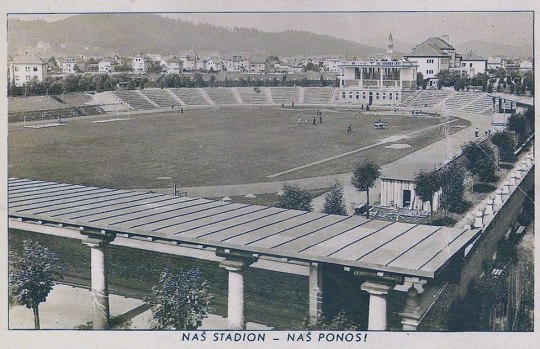
A consortium of public (the Municipality of Ljubljana and the Olympic Committee of Slovenia) and private partners (the businessman Joc Pečečnik and his company) has been promoting the project for more than a decade against strong and growing resistance from both professionals and the broader public. With 'Plečnik’s Ljubljana' a main tourist attraction and the state supporting its nomination for UNESCO World Heritage status, how could the destruction of one of his major works gain official support and approval? Whatever the final decision is about building or not building the stadium, we can say for certain that the investor has already scored at least one major victory: the stadium consortium’s financial and media muscle means that the destruction of one of the central works of the most famous Slovene architect is a realistic scenario.
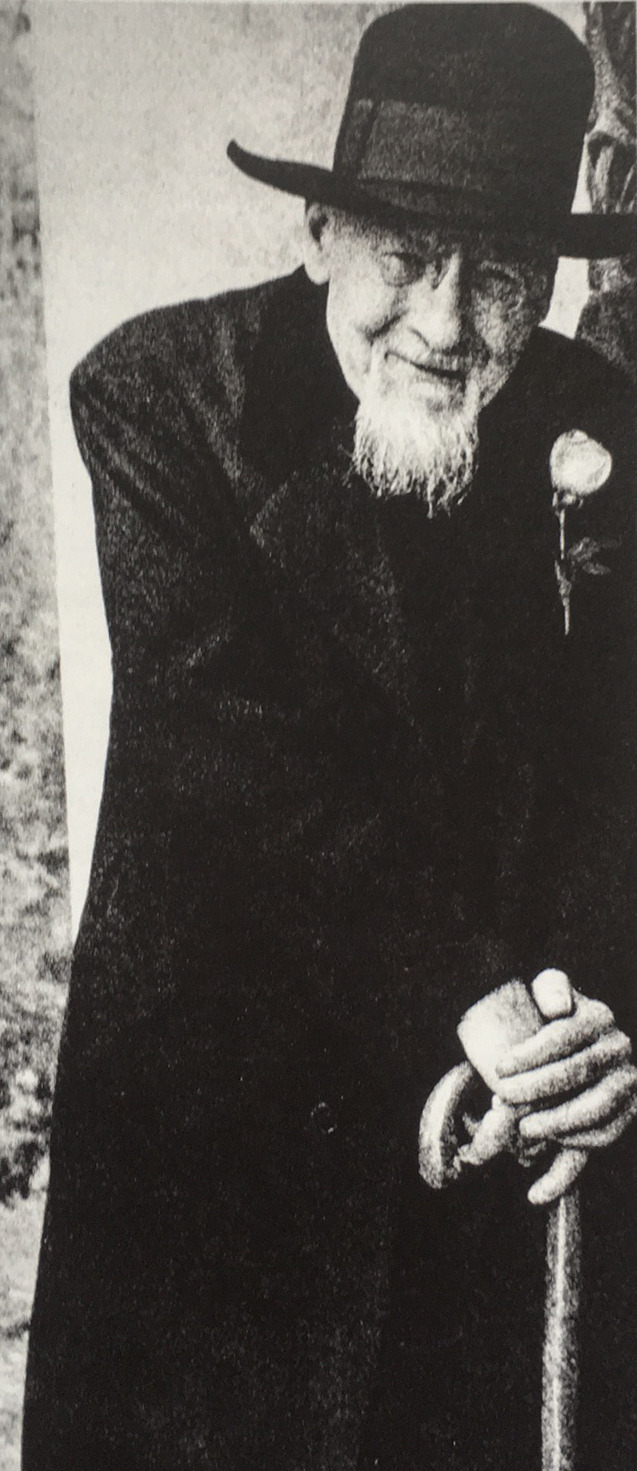
Plečnik on the Brioni Islands (1956). | Photo © Lojze Gostiša
Jože Plečnik (1872-1957) was a carpenter’s son, born in Ljubljana. In 1894, Otto Wagner, the most famous Viennese architect of the time, picked him out of a furniture design studio for his imagination and drawing skill. He soon became one of Wagner’s star pupils, and after graduation began to make his mark in the imperial capital with his avant-garde combination of modernism and classicism. A wider success followed soon after the end of the First World War, when Tomáš Masaryk, the president of the newly-created Czechoslovak republic, commissioned him to renovate the ancient Prague castle to become the official residence of the president.
At around the same time, Plečnik accepted the post of professor of architecture at the new University of Ljubljana, and began his gradual transformation of his provincial Austro-Hungarian hometown into the national capital of Slovenia. This was the beginning of Plečnik’s Ljubljana, as his idiosyncratic classicism changed both the physical fabric and the atmosphere of the city into a modern version of ancient Athens. In Plečnik’s scheme, the stadium by the main city avenue played a central role.

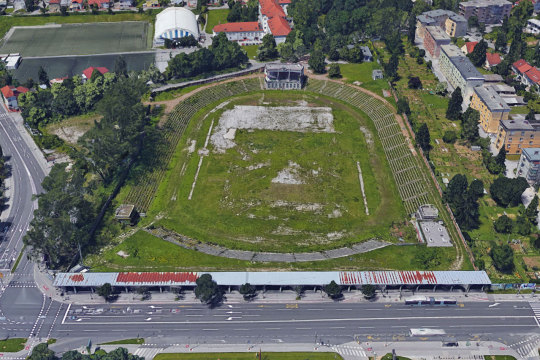
Construction of the stadium for the Roman Catholic youth sport association Orel began in 1925, but political and financial difficulties meant that it was not completed until 1935. | Photo via Outsider
The lengthy construction period and limited funds did not deter Plečnik, and one of his great strengths was his ability to improvise both materially and conceptually throughout the project.

The monumental colonnade created a civic stoa or covered walkway that links the stadium enclosure with the city beyond as well as prviding for a covered space for people to queue. | Photo © Peter Krečič
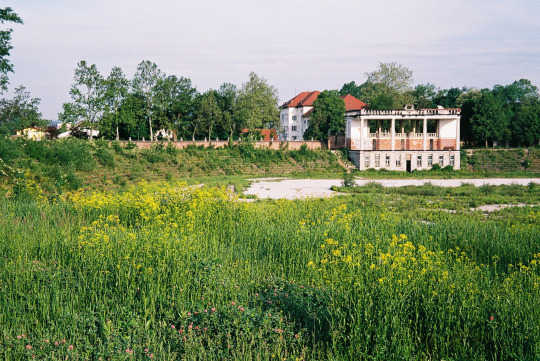
At the other end is the columned ‘Glorietta’, the stadium’s grandstand, which visually dominates the low complex, rising high above the visitors’ seats. | Photo via Failed architecture
For the most part, Plečnik made use of the existing terrain, so that architecture and landscape become an inseparable unity in his vision of the new space. The tree-lined avenues at the edges provide a visual accent of the enclosure, while the ingeniously-designed low brick walls divide the auditorium from the rest of the city, allowing a gradual transition from the wide and busy road on the one side to the low-level single-family houses with gardens on the other.
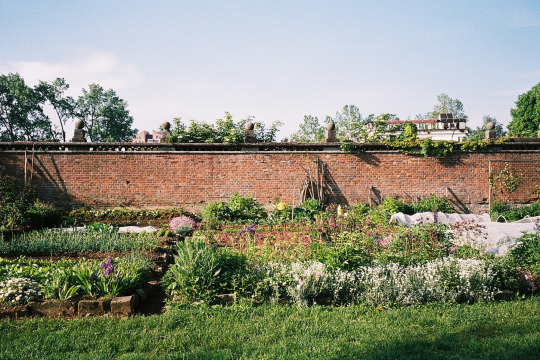
The communal gardens of the nearby Fond Blocks represent a sustainable and community-driven space at the northern edge of the complex, which has survived since the 1930s. | Photo via Failed architecture
The stadium became one of the central venues for landmark sport, music and political events in the history of the city and of the country. Later, it was converted into a football stadium, but its design and infrastructure were not ideal for this purpose. In 2010, a new football stadium was opened next to the the city motorway ring, and the old Plečnik stadium was closed.
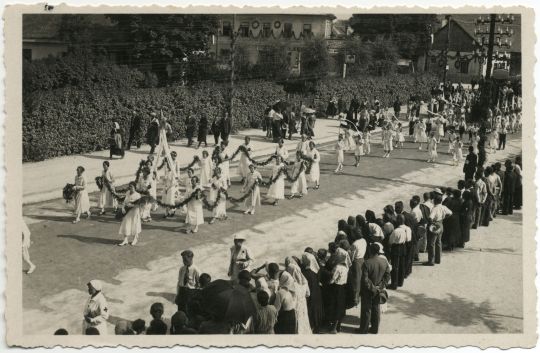

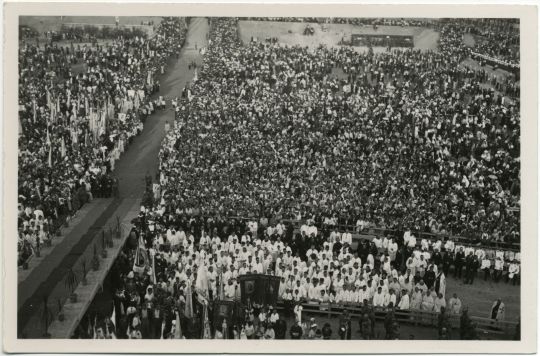
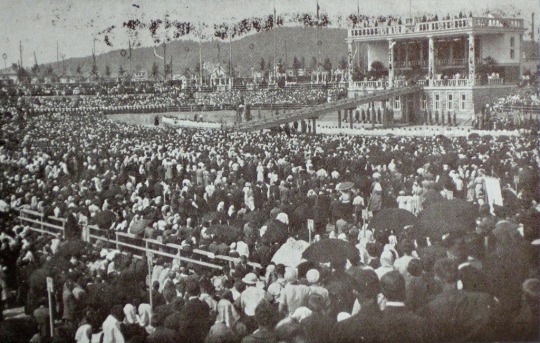
Different events during the history, also the first Eucharistic Congress in 1935 among them. | Photos via Nonument
It was at this point that the campaign for the radical reconstruction of the area began. In 2008 a public-private consortium led by Pečečnik and the Municipality called for an international competition, which was won by the GMP Architectural office from Berlin. The architects proposed extensive new construction to ‘optimise’ the commercial return on the extremely valuable plot. Almost all of the buildings would be torn down, with the site excavated to a depth of 22m and built up with basements of car parks and sport halls on five levels. Above the ground, a new stadium, with covered seating and VIP boxes on three levels, would be built, while around the outer edges of the new stadium, there would be an 18-storey skyscraper and three apartment blocks on the site of the communal gardens. Almost all of the Plečnik Stadium (except for the Glorietta and the colonnade) would have to be demolished.


The stadium in the 1950s and today, overgrown by vegetation. | Photo © Edi Šelhaus, Failed architecture
As a compromise, the investor has promised to rebuild the wall around the perimeter of the plot to the original plans and provide for the visitor stands where the old auditoriums were situated. Despite the almost total destruction of the stadium, the project has consistently been branded as the preservation of Plečnik’s legacy, reinforced by the fact that the stadium – now in the ownership of the stadium consortium – has been decaying ever since its closure. Redevelopment is, the investor claims, the only way to save the stadium, at an estimated cost of 240 million Euros while providing 800 new jobs.



Proposed reconstruction. | Rendering by GMP Architekten
Pressure from political and private interests has led to the project gaining widespread official approval, including that of the Heritage Protection Agency. This raised many eyebrows, as the Plečnik stadium was awarded the highest possible protection status of 'Heritage of National Importance' in 2010 (of course, the stadium is not part of the UNESCO nomination, because of its present status and uncertain future). The independent civic society and professional architectural, heritage and art-historical societies are all united in their opposition to the destructive plans. The international limelight was added to the redevelopment plans by the inclusion of the Stadium on the list of 7 most endangered European cultural heritage sites in 2020 by the NGO Europa Nostra. All of these organizations argue that redevelopment in this case means destruction only, with less than five per cent of the stadium preserved, while building up the whole of the plot would destroy not only the physical substance of Plečnik's masterpiece but also the spatial totality of the public, urban recreational facility the stadium has always been. Ljubljana's many unfinished construction sites raise further concern; economic uncertainty could mean that the consortium would have enough money to destroy a heritage site, but not to bring its plans to fruition. The new facility also seems unnecessarily ambitious, as a new stadium in Stožice meeting international standards is already built and operating well, and Ljubljana, a city of 300,000, has no need for two state-of-the-art football stadiums. The plans for the public part of the complex could be just a way of convincing stakeholders to sanction the destruction of heritage, with the end-product even less public and more commercial.
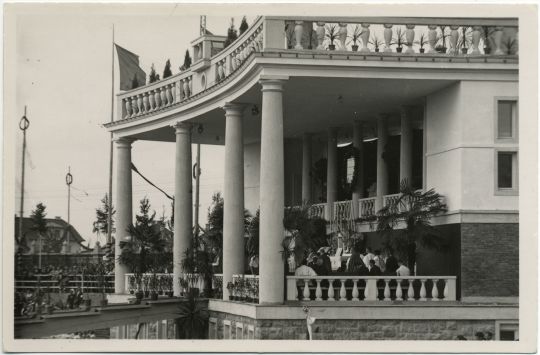
No one from the Municipality or the state will admit that the choice between the slow decay of the stadium and rapid destructive redevelopment is a false one. According to the esimates by the Ministry of Culture the third option, a faithful renovation of the complex as a civic recreation and sports park, would cost just around 3 million euros (1 per cent of the BSP project estimate). Such a low renovation estimate is possible because of a simple and economic conception of the original stadium, a consistent feature of Plečnik’s architecture in general. Ljubljana, a much richer and better-educated city than it was in 1935, seems to have lost the qualities of the great architect that gave it its shape.
-- Miloš Kosec
This article was first published in C20, the magazine of the C20 Society. See for more information or to join www.c20society.org.uk.
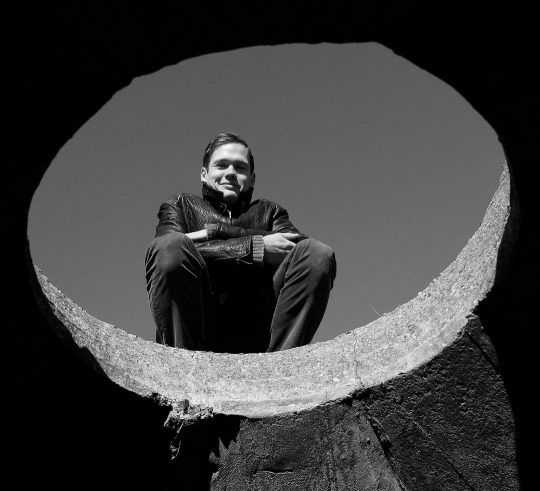
Photo © Stine Alling Jacobsen
Miloš Kosec is an architect, editor and publicist living and working in Ljubljana, Slovenia. He graduated from the Faculty of Architecture of Ljubljana University with the Master's thesis »Ruin as an Architectural Object«, which was published as a book in 2013. Miloš completed his PhD in 2019 at Birkbeck College, University of London, with a thesis »Passivism: Activism and Passivity in Contemporary Architecture«. He is researching, exhibiting, writing and publishing articles in professional and academic publications, focusing primarily on architecture, architectural history, political and social aspects of architectural design. Together with the Outsider magazine editorial board, he was one of the recipients of Plečnik medal for contributions to architectural culture in 2017. Miloš is also a practicing architect and landscape designer with a number of landscape realizations. In 2018, he was one of the authors of the Slovene pavilion at the Venice Architecture Biennial. He is a member of the editorial board of Outsider Magazine. He is also a member and a researcher of the international art and research project Nonument and is a frequent participant in international architecture conferences and events.
9 notes
·
View notes
Photo
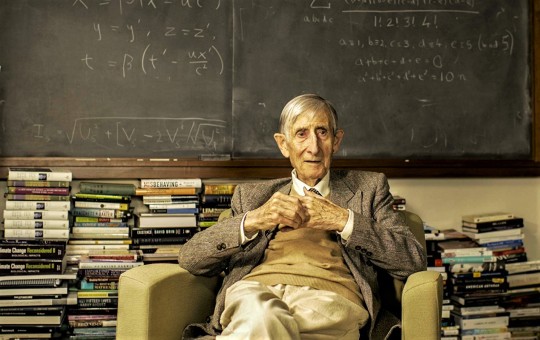
The physicist Freeman Dyson, who has died aged 96, became famous within science for mathematical solutions so advanced that they could only be applied to complex problems of atomic theory and popular with the public for ideas so far-fetched they seemed beyond lunacy.
As a young postgraduate student, Dyson devised – while taking a Greyhound bus ride in America – the answer to a conundrum in quantum electrodynamics that had stumped giants of physics such as Richard Feynman and Hans Bethe. As an author, guru and apostle for science, Dyson also cheerfully proposed that humans might genetically engineer trees that could grow on comets, to provide new habitats for genetically altered humans.
He had already proposed the ultimate solution to the energy crisis: a sufficiently advanced civilisation would, he argued, crunch up all the unused planets and asteroids to form a giant shell around its parent star, to reflect and exploit its radiation. Science fiction writers were delighted. The first suggestion became known as the Dyson tree. The second is called the Dyson sphere.
He was born in Crowthorne, Berkshire. His father, George Dyson, was a musician and composer, and his mother, Mildred Atkey, a lawyer. The young Dyson reported that his happiest ever school holiday – from Winchester college – was spent working his way, from 6am to 10pm, through 700 problems in Piaggio’s Differential Equations. “I intended to speak the language of Einstein,” he said in his 1979 memoir Disturbing the Universe. “I was in love with mathematics and nothing else mattered.”
He graduated from Cambridge and in 1943 became a civilian scientist with RAF Bomber Command, which experienced hideous losses with each raid over Germany. Dyson and his colleagues suggested that the Lancaster bomber’s gun turrets slowed the plane, increased its burden and made it more vulnerable to German fighters: without the turrets, it might gain an extra 50mph and be much more manoeuvrable.
He was ignored. Bomber Command, he was later to write, “might have been invented by a mad scientist as an example to exhibit as clearly as possible the evil aspects of science and technology: the Lancaster, in itself a magnificent flying machine, made into a death trap for the boys who flew it. A huge organisation dedicated to the purpose of burning cities and killing people, and doing it badly.”
The young Dyson was already convinced of some moral purpose to the universe and remained a non-denominational Christian all his life.
After the second world war he went to Cornell University in New York state to begin research in physics under Bethe, one of the team at Los Alamos that fashioned the atomic bomb.
By 1947, the challenge was one of pure science: to forge an accurate theory that described how atoms and electrons behaved when they absorbed or emitted light. The broad basis of what was called quantum electrodynamics had been proposed by the British scientist Paul Dirac and other giants of physics. The next step was to calculate the precise behaviour inside an atom. Using different approaches, both Julian Schwinger and Feynman delivered convincing solutions, but their answers did not quite square with each other.
It was while crossing Nebraska by bus, reading James Joyce and the biography of Pandit Nehru, that the young Dyson saw how to resolve the work of the two men and help win them the 1965 Nobel prize: “It came bursting into my consciousness, like an explosion,” Dyson wrote. “I had no pencil and paper, but everything was so clear I did not need to write it down.”
A few days later he moved – for almost all of the rest of his life – to the Institute of Advanced Study at Princeton, home of Albert Einstein and Robert Oppenheimer, the father of the atomic bomb. “It was exactly a year since I had left England to learn physics from the Americans. And now here I was a year later, walking down the road to the institute on a fine September morning, to teach the great Oppenheimer how to do physics. The whole situation seemed too absurd to be credible,” Dyson wrote later.
He went on to deliver a series of papers that resolved the problems of quantum electrodynamics. He did not share in Feynman’s and Schwinger’s Nobel prize. He did not complain. “I was not inventing new physics,” he said. “I merely clarified what was already there so that others could see the larger picture.”
Dyson tackled complex problems in theoretical physics and mathematics – there is a mathematical tool called the Dyson series, and another called Dyson’s transform – and enjoyed the affection and respect of scientists everywhere. He took US citizenship, and worked on Project Orion, one of America’s oddest and most ambitious space ventures.
Orion was to be an enormous spacecraft, with a crew of 200 scientists and engineers, driven by nuclear weapons: warheads would be ejected one after another from the spaceship and detonated. This repeated pulse of blasts would generate speeds so colossal that the spacecraft could reach Mars in two weeks, and get to Saturn, explore the planet’s moons, and get back to Earth again within seven months. Modern spacecraft launched by chemical rockets can take 12 months to reach Mars, and more than seven years to reach Saturn.
The Orion project faltered under the burden of technical problems, and then was abandoned in 1965 after the partial test ban treaty that outlawed nuclear explosions in space.
Dyson was a widely read man with a gift for memorable remarks and a great talent for presenting – with calm logic and bright language – ideas for which the term “outside the envelope” could only be the most feeble understatement.
In 1960, in a paper for the journal Science, he argued that a technologically advanced civilisation would sooner or later surround its home star with reflective material to make full use of all its radiation. The extraterrestrials could do this by pulverising a planet the size of Jupiter, and spreading its fabric in a thin shell around their star, at twice the distance of the Earth from the sun. Although the starlight would be masked, the shell or sphere would inevitably warm up. So people seeking extraterrestrial intelligence should first look for a very large infrared glow somewhere in the galaxy.
In 1972 – a year before the first serious experiments in manipulating DNA – Dyson outlined, in a Birkbeck College lecture, in London, his vision of biological engineering. He predicted that scavenging microbes could be altered to harvest minerals, neutralise toxins and to clean up plastic litter and hazardous radioactive materials.
He then proposed that comets – lumps of ice and organic chemicals that periodically orbit the sun – could serve as nurseries for genetically altered trees that could grow, in the absence of gravity, to heights of hundreds of miles, and release oxygen from their roots to sustain human life. “Seen from far away, the comet will look like a small potato sprouting an immense growth of stems and foliage. When man comes to live on the comets, he will find himself returning to the arboreal existence of his ancestors,” he told a delighted audience.
He went on to predict robot explorers that could replicate themselves, and plants that would make seeds and propagate across the galaxy. Plants could grow their own greenhouses, he argued, just as turtles could grow shells and polar bears grow fur. His audience may not have believed a word, but they listened intently.
Dyson had a gift for the memorable line and a disarming honesty that admitted the possibility of error. It was, he would say, better to be wrong than to be vague, and much more fun to be contradicted than to be ignored. Dyson was by instinct and reason a pacifist, but he understood the fascination with nuclear weaponry.
He enjoyed unorthodox propositions and contrarian arguments; he maintained a certain scepticism about climate change (“the fuss about global warming is greatly exaggerated”) and he argued that a commercial free-for-all was more likely to deliver the right design for spacecraft than a government-directed effort.
He had little patience with those physicists who argued that the world was the consequence of blind chance. “The more I examine the universe and the details of its architecture, the more evidence I find that the universe must in some sense have known we were coming,” he once said.
His Cambridge mentor, the mathematician GH Hardy, had told him: “Young men should prove theorems, old men should write books.” After Disturbing the Universe, Dyson wrote a number of compelling books, including Infinite in All Directions (1988) and Imagined Worlds (1997). In 2000, he was awarded the Templeton prize – worth more than the Nobel – given annually for progress towards discoveries about spiritual realities.
He was a frequent essayist and to the end a contributor to the New York Review of Books. But he continued to think as a scientist and in 2012 entered the field of mathematical biology with a published paper on game theory in human cooperation and Darwinian evolution.
Dyson is survived by his second wife, Imme (nee Jung), whom he married in 1958, and their four daughters, Dorothy, Emily, Mia and Rebecca; by a son, George, and daughter, Esther, from his first marriage, to Verena Huber, which ended in divorce; and by a stepdaughter, Katarina, and 16 grandchildren.
• Freeman John Dyson, mathematician and physicist, born 15 December 1923; died 28 February 2020
Daily inspiration. Discover more photos at http://justforbooks.tumblr.com
95 notes
·
View notes
Photo

Sign for Greenford Quay development on a lopsided street sign, Birkbeck Avenue, Greenford, London Borough of Ealing, London, UK, April 2021. #sign #signage #streetfurniture #development #road #Greenford #LondonBoroughofEaling #London #UK #April2021 #suburbs #suburban #suburbia #lockdown #lockdownwalks #photography
#grey#black#yellow#white#green#brown#sign#signage#development#streetfurniture#road#Greenford#LondonBoroughofEaling#London#UK#April2021#suburbs#suburban#suburbia#lockdown#lockdown walks#photography
1 note
·
View note
Text
The skies in "The Scream" might be based on this strange weather pattern.

You don't have to know a lot about art history to recognize "The Scream" — it's the one with the wavy-looking person holding both hands to its face, mouth agape in anguish. The shape of the person is just an artistic representation, of course, but the spooky skies driving the subject of the painting to despair might be based on a real meteorological event. It's more than possible; it's likely, according to a new report published in the Bulletin of the American Meteorological Society.
Cloudy Visions
It's no exaggeration to say "The Scream" ranks up there with the "Mona Lisa" or Michelangelo's "David" as one of the most universally recognized pieces of fine art in the world. But what really makes the piece special is the depths of emotion that it conveys. It isn't clear from looking what is causing the main figure such distress, but Edvard Munch's inscription on the frame of the original 1893 painting suggests that, abstract as it may be, it was also based at least in part on true events:
I was walking along the road with two friends
—the sun was setting
—I felt a wave of sadness—
—the Sky suddenly turned blood-red
I stopped, leaned against the fence
tired to death—looked out over
the flaming clouds like blood and swords
—the blue-black fjord and city—
—My friends walked on—I stood
there quaking with angst—and I
felt as though a vast, endless
scream passed through nature.
It's an evocative question, and it's fueled a century or so of speculation about what, exactly, "The Scream" depicts. Some theories state that the blood-red imagery is merely a metaphor for Munch's feelings at the time. The boardwalk depicted in the painting would have led Munch to the mental asylum where his sister had been admitted, and "The Scream" may refer to both the despair he felt for his sister and the fear he felt that he would face the same fate. At the same time, the specific mention of the clouds lends something to the idea that Munch really did witness something that disturbed him (while he was already in a rather disturbed state of mind).
An Opalescent Explanation
According to the team of meteorologists made up of Fred Prata from the University of Oxford, Alan Robock of Rutgers, and historian Richard Hamblyn of Birkbeck, the background of Munch's resembles nothing so much as nacreous clouds, also known as mother-of-pearl clouds. These rare formations were once seen only at the uppermost latitudes (although human impact has caused them to appear more frequently and closer to the equator in recent years). They're long, wavy, and fill the sky with light in many strange colors. In other words, they look very much like the bright-red and gunmetal-blue background in the painting.

It's not just a matter of passing resemblance, either. Although rare, the clouds form with some regularity in Oslo, where Munch lived at the time. As evidence in the paper, Prata submits photos he himself took of the nacreous clouds hovering low in the sky over southern Oslo. Frankly, they're practically a dead-ringer for the clouds in Munch's painting. There's just one thing that's missing: Munch's clouds aren't at all iridescent: a key feature of the strange cloud formation.
A Lava-ly View
Let's be clear: At this point, we can't say for sure that nacreous clouds were really the inspiration for the painting. Another theory, one that goes back further than this newer idea, says that the blood-red sky Munch saw was the result of a volcanic sunset — perhaps even one of the many caused by Krakatoa. When the massive volcano exploded in the South Pacific in 1883, it caused a shift in weather patterns all over the world, including causing roughly a year or two of vividly colorful sunsets as far away as northern Europe. The only problem with the Krakatoa theory is that those sunsets would have been long since finished by the time Munch created his paintings. Plus, the Edvard Munch of 1883 was not nearly the anguished soul he would be some eight years later.
Of course, that's not exactly a nail in the coffin for the volcano hypothesis, either. There's no reason Munch couldn't have been referencing a particularly vivid sunset he saw back in the days of Krakatoa. There were also other volcanic candidates, like Awu in 1893, that might have painted the sky red over Europe. Still, there's the uncanny resemblance the painting bears to iridescent mother-of-pearl clouds. At the end of the day, we can probably say a few things for certain: Edvard Munch probably did see volcanic sunsets in his day, and he probably saw nacreous clouds as well. He also probably experienced many of these sights through an emotionally charged lens. Is "The Scream" a painting of nacreous clouds? We'll never know for sure, but there's a good chance they at least influenced his dark vision.
Source: Curiosity app
Article written by: Reuben Westmaas on 8/17/2018

#The Scream#art#artwork#art history#Food and Culture#weather#famous paintings#famous works of art#Bulletin of the American Meteorological Society#Edvard Munch#art interpretation#fear#clouds#nacreous clouds#mother-of-pearl clouds#Norway#art theory#Awu volcano#volcanic sunsets#Curiosity app#arts and humanities#visual arts#expressionism#impressionism#famous artists#famous painters
23 notes
·
View notes
Text
Treachery and treason
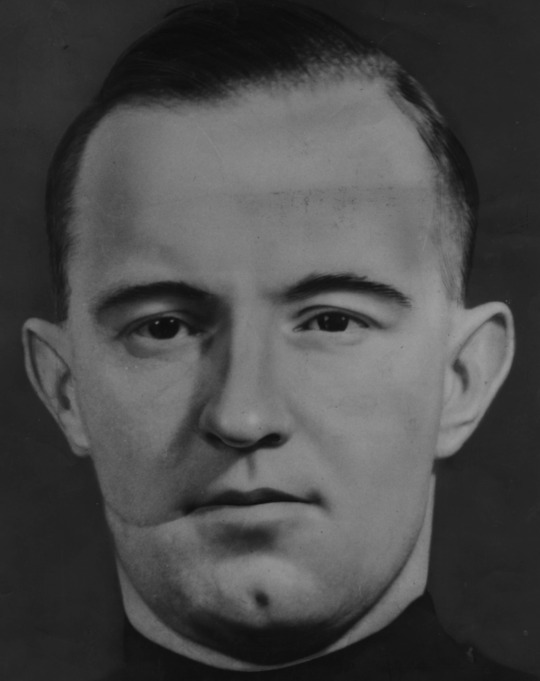
Words: Mark Bryant; Photo by Paul Popper/Popperfoto/Getty Images
This year, 2019, not only marks the 80th anniversary of the beginning of the Second World War, but also the departure for Nazi Germany of a former Dulwich resident who became one of modern history’s most notorious propagandists – William Joyce, better known as “Lord Haw-Haw”.
Joyce was born in Brooklyn, New York, on April 24 1906, the eldest of four children of an Irish émigré builder and a doctor’s daughter from Lancashire. When he was three the family returned to Ireland and 12 years later he was sent to England to stay with his mother’s relations in Oldham.
Intending to study medicine, he moved to London in 1922 to attend the Battersea Polytechnic Institute (later the University of Surrey in Guildford), while living in digs nearby.
The following year his parents and siblings moved to Allison Grove, Dulwich, just off what is now the south circular near West Dulwich Station, and William joined them. His father had set up shop as a grocer nearby.
Their new home, to paraphrase from Rebecca West’s book The Meaning of Treason (1949), was “a house as delightfully situated as any in London. Allison Grove is a short road of small houses which has been hacked out from the corner of the gardens of a white Regency villa in the greenest part of Dulwich.
“Not far off is Mill Pond, still a clear mirror of leaves and sky, and beyond it Dulwich College amidst its groves and playing fields. The neighbours all noted that William was the apple of the family’s eye, and they could understand it, for the boy had an air of exceptional spirit and promise.”
However, his studies at the polytechnic did not go well and he failed his exams soon after moving to Dulwich. Undaunted (he was still only 17), he got a place to study English at Birkbeck College, University of London.
While at Birkbeck he became chairman of the Conservative Student Society and had ambitions to become a Tory MP.
In December 1923, while still a student, he also became a member of the British Fascists (BF) group which canvassed for the Conservative and Unionist parties and acted as stewards for their meetings.
In the run-up to the general election of October 1924, Joyce was a steward at a rally at Lambeth Baths hall near the Imperial War Museum (now the site of Lambeth Towers) for the Unionist candidate for Lambeth North, Jack Lazarus.
However, a fight broke out with Communist hecklers and Joyce was badly slashed in the face by a razor. The Evening Standard reported the incident on its front page, quoting Lazarus as saying “The man Joyce, one of our supporters, fell down, his face covered in blood”. The article continued: “Mr William Joyce, of Allison Grove, Dulwich, had... to be confined to hospital.”
A week after his 21st birthday, when he was still living at home in Dulwich, he secretly married a fellow Birkbeck student. In June 1927 he received a first class degree in English and soon afterwards began a postgraduate course in philology.
He and his wife then moved to Chelsea, where he joined the Conservative Party (he had left the British Fascists in 1925) and, having failed to be nominated as a Tory candidate, he tried unsuccessfully to get a job at the Foreign Office. He then worked as a tutor of languages and history at the Victoria Tutorial College in Eccleston Square.
By 1932 he and his family (which then included two daughters) had moved south of the river again and settled in a flat on Farquhar Road in Gipsy Hill, near the Crystal Palace before it burnt down. The house was within walking distance of Joyce’s parents in Dulwich.
While on Farquhar Road Joyce continued working as a tutor and, having given up his philology course, he began to study part-time for a PhD in educational psychology at King’s College London.
Meanwhile, he joined Oswald Mosley’s newly founded British Union of Fascists (the Blackshirts) in August 1933 and when he was offered a well-paid job working for the BUF in November, he gave up his PhD and his tutoring work. Within two years he became the BUF’s director of propaganda and deputy leader.
Meanwhile, his relationship with his wife had deteriorated and in 1936 the marriage was dissolved. He then remarried and moved to north London. As Rebecca West says: “He left south London, which had been his home since he was a boy with the exception of a few brief episodes; which was still the home of his father, Michael Joyce, and his mother, Queenie, and his brothers and sister.”
However, before long he returned to Dulwich. In 1937 he left the BUF and founded – with ex-BUF members John Beckett (fomerly the independent Labour MP for Peckham) and John McNab – his own party, known as the National Socialist League.
The NSL held a number of meetings in Dulwich on the corner of Calton Avenue and Dulwich Village, outside Dulwich Library on Lordship Lane and sometimes inside when permission for the use of St Barnabas’ Parish Hall in Dulwich Village was refused).
His brothers also supported the NSL. To paraphrase Mary Kenny: “Frank had spoken for the Mosley Blackshirt movement on a couple of occasions, mostly at local meetings in Dulwich. Quentin also became caught up in the fringes of fascist politics because of his unquestioning devotion to his brother William.
“Indeed, William seems to have roped in his whole family. He even had his teenage sister, Joan, hand out Fascist propaganda leaflets at Sydenham School for Girls. He also dressed little Robert up in a black shirt. ‘Poor Mrs Joyce!’ the neighbours in Dulwich used to exclaim. ‘With all those terrible children in their black shirts!’”
The NSL was disbanded in 1939 and Joyce and his wife moved to Germany on August 26 that year, only days before the Second World War broke out. Within a short while he began his infamous nightly propaganda broadcasts to Britain prefaced with the words “Germany calling”.
The nickname Lord Haw-Haw originated from an article written by Daily Express radio critic Jonah Barrington, who added: “I imagine him with a receding chin, a questing nose, thin yellow hair brushed back, a monocle, a vacant eye, a gardenia in his button-hole. Rather like PG Wodehouse’s Bertie Wooster.”
In 1939 Barrington produced a humorous book, Lord Haw-Haw of Zeesen – one of the German radio stations Joyce broadcasted from). It was illustrated by the cartoonist Ian Fenwick, who was killed during the war.
Many other cartoonists lampooned Lord Haw-Haw including William Heath Robinson and Leslie Illingworth, who lived in Dulwich in the 1960s. The Beano comic’s “Lord Snooty” strip even featured him during the war.
He was also the butt of comedians such as Max Miller in the revue Haw-Haw at the Holborn Empire, Arthur Askey as “Baron Hee-Haw” on BBC radio’s “Band Waggon”, Geoffrey Sumner, presenting “Nasty News” on British Pathé newsreels and the Western Brothers in their song Lord Haw-Haw, the Humbug of Hamburg.
Joyce broadcast throughout the war years but, ironically, one of the first German bombs to land on Dulwich during the London Blitz in August 1940 completely destroyed his family home. His parents, sister and youngest brother then moved into a flat on Underhill Road, East Dulwich.
His parents both died there in the 1940s, after which his sister and brother Quentin lived in the flat for a while. Quentin was arrested as a possible spy in 1939 but was released from prison in 1943. He later married and lived nearby in Sydenham Hill.
His other two brothers, Frank and Robert, both served in the British Army during the war. Frank’s first wife was the daughter of Harry Weeks, who ran the Magdala pub in Lordship Lane (now The Lordship).
In the last days of the war Joyce was captured by the Allies and put on trial. By a strange quirk of fate the chief prosecutor was Old Alleynian Sir Hartley Shawcross (the future Lord Shawcross), who later became chairman of the board of governors of Dulwich College and was president of the Alleyn Club.
At first it seemed that Joyce might be acquitted as he was born in the USA (and was thus not a UK citizen), but he was eventually condemned of high treason and hanged as a result of his application for a British passport in 1933 while living in Farquhar Road.
In 2009, when she was in her 80s, Joyce’s elder daughter Heather, interviewed on BBC Radio 4, said that she was at boarding school when war broke out and was not aware of his activities.
However, she added: “I saw him in my mind’s eye at the parental home, where my grandparents lived, in Allison Grove and he was pacing the carpet of their living-room with the lace curtains and the piano, and he had his little German songbook and he was walking up and down and he was singing, ‘Dulwich-Land, Dulwich-Land Uber Alles’.”
William Joyce died in Wandsworth Prison on January 3, 1946 aged 39. He was the last person to be executed for high treason in the UK.
Mark Bryant lives in East Dulwich and is the author World War II in Cartoons and other books.
1 note
·
View note
Text
Graham Folger Disappears (MAG – 003 – Across the Street)
MAG – 003 – Across the Street:
Statement of Amy Patel, regarding the alleged disappearance of her acquaintance Graham Folger. Original statement given July 1st 2007. Audio recording by Jonathan Sims, Head Archivist of the Magnus Institute, London.
Regarding: Acquaintance at community college, Graham Folger, writes constantly in notebooks, has a hypnotic table, and eventually disappears and becomes a new physical person ("Not Graham"). Statement-giver Amy lived across the street and watched him.
People:
Amy Patel
Graham Folger
Shifting multi-limbed creature
"Not Graham"
Graham's parents who died in car crash on Aug. 4, 2001
Places:
Birkbeck University
Clapham
Misc.:
Hypnotic table with missing center
Smoking
Journals
Notebooks
"Keep Watching"
Key Language:
I initially found Graham a bit off-putting, to be honest. He was a chain smoker and wore far too much deodorant to try and cover the smell. He was a bit older than me, maybe ten years or so. I never asked his age, I mean, we weren’t that close, but he was starting to grey at the edges of his hair, and you could see that the tiredness on his face wasn’t just from missing a single night’s sleep. That’s not to say he was bad looking – he had a round, open sort of face and quite deep blue eyes, but very much not my type. He was well-spoken in group work, at least when he did speak, and I think it came up once that he’d been to Oxford, though I don’t know what college.
I’d noticed earlier that during lectures he always seemed to be scribbling furiously in a notebook even when the lecturer wasn’t speaking. At first I just thought he was thorough, but I swear I watched him fill a whole A5 notebook in one lecture. I remember it was a talk on youth and the justice system where the speaker was so slow that it wouldn’t have filled that book even if Graham had been writing down literally every word. Not to mention I asked to borrow his notes once for an essay, and he gave me this weird look and said he didn’t take any notes.
[....]
It was there that I saw Graham. He was sat right at the front, staring out of the window. People-watching is one of my guilty pleasures, so I decided not to say hello, at least not right away. I wasn’t disappointed, either – he was stranger alone than he had ever been during class. It was the middle of winter at this point, so the windows were solid with condensation, but he almost obsessively wiped it away from the one in front of him the moment it started to obscure his view. He seemed to be intently scanning the street for something, except that at times he would crane his neck to stare at the roofs of the buildings passing by. He seemed nervous, as well, and was breathing way faster than normal, which fogged up his window even more. It was slightly alarming to watch, to be honest, and I finally made up my mind to tell him I was there.
[....]
I decided to just walk back with him as far as necessary and make sure he didn’t see what building I went into. Maybe we weren’t even walking in the same direction. Yeah, we were walking in exactly the same direction. We even seemed to be heading to the same street.It was at that point I felt a hand grab my shoulder and throw me into the road. I don’t know how else to describe it, one moment I was walking along, the next I was flying towards the ground. It can’t have been Graham – he was in front of me at the time, and I would have sworn there was nobody else on the street. There weren’t any cars coming, but I hit my head hard. I think I must have been unconscious for a few seconds, because the next thing I remember is a panicky Graham on the phone to an ambulance. I tried to tell him I was alright, but didn’t really manage to get the words out, which, yeah, probably meant I wasn’t alright.
[....]
As it turned out, Graham’s flat was directly across the street from mine, just a couple of floors lower. I wondered if I could see my window from his, and I remember I had the odd thought that, if I had to look out, I’d need to be careful of his window box, as I could see the hooks attaching it to the frame. I asked him what he grew, and he gave me a look, as though my concussion had stopped me making sense again. I mean, maybe it had, because when I looked back at the window the hooks were gone, and there was no sign of any window box. At the time I put it down to my head wound, and even now I’m not sure.
The flat itself was a simple affair, quite big by London standards. It had only a few pieces of furniture and a lot of bookshelves, each covered with rows and rows of identical notebooks, with no apparent marking system or indication of contents. I started to ask about them, but my head throbbed and I didn’t feel up to any answer that might have been forthcoming. Graham led me to the sofa and disappeared to fetch me an icepack and a mug of sugary tea. I graciously accepted both, though I wasn’t in much of a mood to talk. Graham clearly felt awkward enough with the silence to do the talking for both of us, and I learned more about him over the next hour than I’d ever had a desire to know. Apparently his parents had died in a car accident a few years previously and had left a great deal of money and ownership of this flat. He didn’t need to work anymore and so had found himself somewhat adrift, taking night college courses to pass the time and broaden his mind - his words, not mine. He said he was trying to figure out what to actually do with his life.
He talked on like this for a while but I stopped listening about that point, as I’d become enraptured by the table on which he’d placed my tea. It was an ornate wooden thing, with a snaking pattern of lines weaving their way around towards the centre. The pattern was hypnotic and shifted as I watched it, like an optical illusion. I found my eyes following the lines towards the middle of the table, where there was nothing but a small square hole. Graham noticed me staring and told me that interesting antique furniture was one of his few true passions.
Apparently he’d found the table in a second-hand shop during his student days and fallen in love with it. It had been in pretty bad shape but he’d spent a long time and a lot of money restoring it, though he’d never been able to figure out what was supposed to go in the centre. He assumed it was a separate piece and couldn’t track it down. And yeah, like most of his conversation, I’d have found it dull even if I wasn’t concussed. But by this time, I was beginning to feel well enough to leave and started to make my excuses to Graham. He expressed his concern, said it hadn’t been as long enough, as the medics suggested, but if I had to… Well, you get the picture. In the end I did leave, as I kept getting lost in the lines of the table, and the pipes outside of the window made such a weird noise that I didn’t think staying was actually going to help me recover.
[....]
He would constantly reorder his journals, without any apparent system of organisation, most of the time without even opening them. Sometimes he would grab an apparently random notebook from the shelves and start scribbling in it, even though I could see that the page was already covered in writing.
Once, and I swear this is true, I saw him take one of his notebooks and start to tear out the pages one at a time. And then, slowly and deliberately, he ate them. It must have taken him three hours to get through the whole book, but he didn’t stop or pause, he just kept going.
Even when he wasn’t doing anything with the notebooks, there was an odd energy to him. From what I could see he was constantly on edge, and jumped every time any loud noise passed on the street below. A police siren, a breaking bottle, hell, I even saw him freak out over an ice-cream truck once. Each time he’d leap to his feet, run to the window and start looking out; wildly craning his neck from side to side. Sometimes he’d look up, but I’d learned his patterns well enough to avoid being spotted. Then, all at once, he’d decide that there was no problem and go back to whatever he was doing before. And by “whatever he was doing before”, yeah, I mean nothing. He apparently didn’t have a television or a computer – the only books he seemed to own were his own notebooks, and I only ever saw him eat takeaway food. I don’t know how many times I watched him eat the same pizza – pepperoni with jalapeño peppers and anchovies. Yeah, I know. But the rest of the time he just sat there, smoking; sometimes looking into space, sometime staring at that wooden table of his.
And yeah, I remembered the pattern was kind of hypnotic and I spent more than a couple of minutes staring at it myself when I was there, but he did almost nothing else.
Who knows, perhaps he had a rich and fulfilling life outside of the flat. He certainly left it regularly enough, and yeah, I wasn’t so far gone as to actually follow him. If fact, I always waited a good long while before leaving my own building to make sure I didn’t bump into him. I still didn’t want him to know where I lived, although now for very different reasons. In the end, though, it was a hobby, not an obsession, and often days would pass when I wouldn’t see Graham at all. Maybe there was stuff I missed that would have explained his behaviour. I just wish I’d missed what happened on April 7th. Then maybe I’d have just thought he’d moved on or… I don’t know. I just wish I hadn’t seen it.
[....]
So when I saw Graham’s light was still on, I decided to spend a relaxing few minutes checking in on him. His light may have been on, but I couldn’t see him, and I wondered if perhaps he’d gone to bed and simply forgotten to turn it off. More likely he was just in the bathroom, so I decided to wait a while longer. As I stared at that window, I realised there was something… I don’t know, off about it. It looked different somehow, but I couldn’t figure out what it was. Then I noticed it. At first I’d just taken it to be a water pipe running down the side of the building, attached just below Graham’s open window. The light from the streetlamps didn’t reach up to his fourth floor flat, and the window ledge cast a shadow that stopped the light from the room illuminating it, but it was long, straight, dark, and from what I could see it just looked like a pipe, except I’d been watching that window for months now, and would have sworn that there had never been a pipe there before. And as I stared at it, it moved. It started to bend, slowly, and I realised I was looking at an arm, along, thin arm. As it bent the joint close to where the arm ended, I think I saw another joint further down, also moving, and bending what I can only assume were elbows; it hooked the end of the limb over through the window. When I say moved, that’s not quite right. It shifted. Like when you stare at one of those old magic eye paintings and you change from seeing one picture into seeing another. I never saw anything I could actually call a hand, but still it pulled itself through his window. It took less than a second, and I didn’t get a good look at what it was, I just saw these… arms, legs? At least four of them, but there might have been more, and they kind of folded themselves through the window in a flash of mottled grey. I think that was the colour – it was mostly a silhouette, and if there was a body or head, it shifted inside faster than I could see it. The moment it was inside, the light in Graham’s flat went out, and the window slammed down behind it.
So yeah, I just kind of stood there for a long time, trying to process what I’d just seen. I could make out some vague movements from inside Graham’s flat, but couldn’t see anything clearly. I finally decided I had to phone the police, though I didn’t have any idea what to tell them. In the end I simply said I’d seen someone suspicious climbing in through a fourth floor window at his address and hung up before they could ask me who was calling. Then I waited and watched the darkened flat opposite. I couldn’t look away – I was convinced that if I stopped staring that… whatever the hell it was would fold itself back out, reach over and step into my home. Nothing came out.
About ten minutes later I saw a police car driving up the street. No sirens, no flashing lights, but they were here, and right away I started to feel better. Looking up, though, I saw the light had come on in Graham’s flat. There was no sign of the thing I’d seen climb in, but as the police pressed the buzzer outside his building, I saw someone walking towards the door to let them in. It wasn’t Graham.
I can’t stress enough how much this was not Graham. He looked completely different. He was maybe a few inches shorter and had a long, square face topped with curly blond hair, where Graham’s had been dark and cut short. He was dressed in Graham’s clothes, though; I recognised the shirt from my months of watching, but he was not Graham. I watched as Not Graham walked to the door and let the two police officers in. They talked for a while, and Not Graham looked concerned and together they started to search the flat. I watched, waiting for the thing to emerge, or for them to find the real Graham, but they didn’t. At one point I saw one of the police pick up a dark red shape that I recognised as a passport. My heart beat faster as a saw her open it and look at Not-Graham, clearly comparing, waiting for the moment when she detected the impostor. But instead she just laughed, shook Not Graham’s hand, and they left. I watched the police car drive away, feeling a sense of helplessness, and when I looked up, he was standing at Graham’s window, looking back at me. I stood there frozen as his wide, staring eyes met mine and a cold, toothy smile spread across his face. Then in one swift motion he drew the curtains, and was gone.
I didn’t sleep that night, and I never saw Graham again. I saw this new person, though, all the time. For the next week I’d see him taking out large, heavy-looking rubbish bags several times a day. It took me a while to realise he was disposing of Graham’s old notebooks, but soon enough the flat was empty of them. I think he did other redecorating, but I never got a good look, as the only time he had his curtains open was when he was staring intently at my flat, which he now did every night. I tried to find evidence of the old Graham, but anything I could find online with a picture – it was always a picture of this new person. I even asked some of my old classmates, but none of them seemed to remember him at all.
Eventually I moved. I really liked my old place in Clapham, but yeah, it just got too much. The last straw was when I was leaving for work one morning, and didn’t realise until too late that Not Graham had left his building at the same time. He greeted me by name, and his voice was nothing like it should have been. I started to make my excuses and hurry away, but he just stared at me, and smiled.
“Isn’t it funny, Amy, how you can live so near and never notice. I’ll need to return the visit someday.”
I moved out a week later, and I never saw him again.
//
Graham Folger definitely existed, and appears to match up with her story. According to coroner’s records, Desmond and Samantha Folger, his parents, died on the M1 near Sheffield on August 4th 2001, and Graham Folger’s name appears on the register of several colleges and universities in and around London over the next few years. The flat she mentioned did belong to Mr Folger, but was sold through an agency in early 2007. All the photographs we’ve been able to source seem to match the description of this “Not-Graham” that Ms. Patel described, except for a few Polaroids, enclosed, which appear to be from the late 80s, and show the two parents alongside a dark-haired teenager who doesn’t match the later photos at all.
There doesn’t seem to be much more to be done here. Ms. Patel, like so many of our subjects, seems to have been more interested in giving her statement as a form of personal closure, rather than as the start of a serious investigation. She wasn’t even interested when Sasha told her we’d managed to locate what we believed to be one of Graham Folger’s journals. Doubt it would have done much good. It just says the same thing on every page: the words “Keep Watching” over and over again.
#mag 003#amy patel#graham folger#“not graham”#clapham#across the street#keep watching#journals#notebooks#smoking#hypnotic table
0 notes